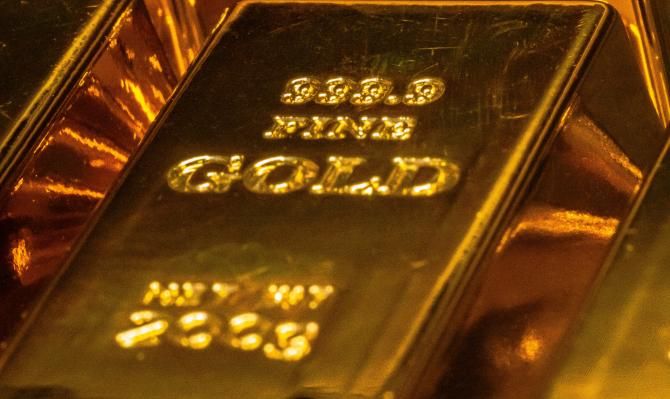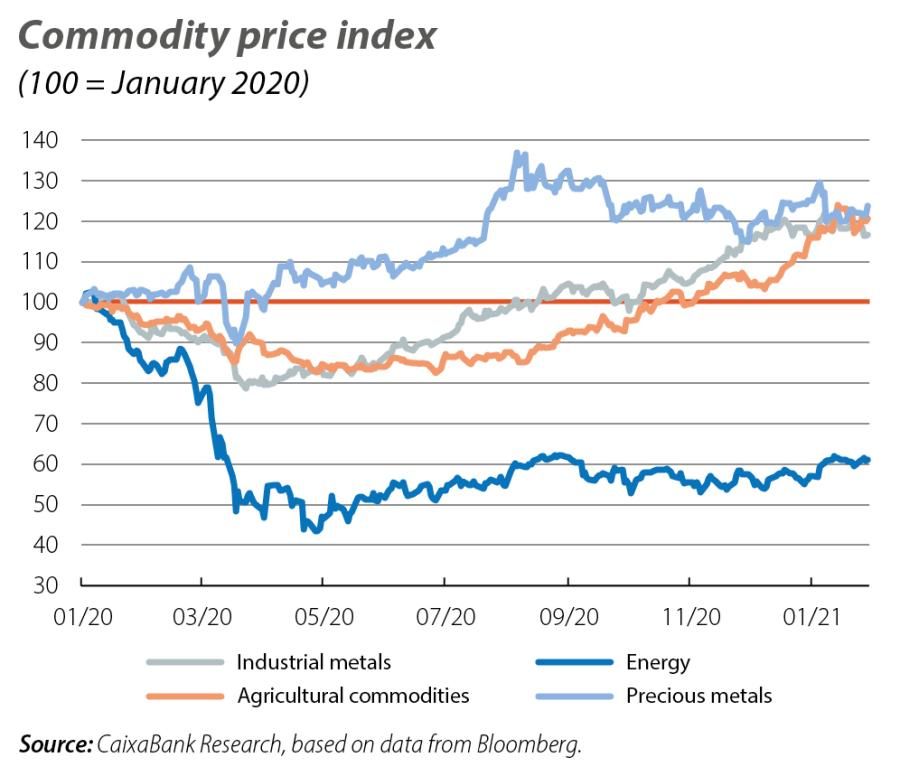Commodities: the resurgence of a market in the midst of the global recession
Why have commodity prices risen when the world economy is going through a far-reaching crisis in the wake of the pandemic? The answer lies in a combination of demand and supply factors and financial aspects.

- Commodity prices ended 2020 with significant growth, whilst the major global economies (except China) suffered sharp declines in their GDP.
- The combination of demand and supply factors and elements of the financial situation have led to a mismatch between commodity prices and activity in the real economy.
The COVID-19 crisis has dealt a major blow to the world economy and plunged it into the deepest recession since World War II. This contraction also spread to the commodity market, where the decline in the prices of many commodities initially drove them to their lowest levels since 2009, with oil leading the race to the bottom. CaixaBank Research estimates suggest that, at the end of 2020, global GDP stood around 3% below its pre-pandemic level. However, this figure stands in stark contrast to the significant recovery in commodity prices, which mostly ended up above their levels of the 2019 year end (see first chart).

Why did commodity prices rise if the global economy was going through a deep crisis? The answer lies in a combination of demand and supply factors and financial elements.
Firstly, we will look at the demand-side catalysts. Following the initial impact of the pandemic, the gradual lifting of mobility restrictions beginning in Q2 and the economic stimulus packages boosted the recovery of economic activity, thus leading to an increase in demand for commodities, particularly those linked to the business cycle. In the autumn, faced with a rise in infections, many countries had to reimpose some of the restrictions on mobility. However, by doing so less stringently, they avoided truncating the recovery in industrial activity and the increase in international trade (which even exceeded its levels of late 2019). Also, unlike the rest of the world, China’s success in controlling the pandemic allowed its economy to continue to grow (+6.5% year-on-year in Q4 2020), largely thanks to its industrial might, and it relaunched its imports of commodities, particularly industrial metals.

In addition, there is another demand-side factor that has favoured the rise in some commodity prices, albeit more in the medium term. As a way to alleviate the negative impact of the COVID-19 crisis on their economies, many governments have designed recovery plans aimed at driving the transformation towards a more environmentally friendly energy system. This has encouraged a rise in the price of metals closely linked to the energy transition, such as copper,1 which by the year end had amassed a 70% increase since its low point in March. Similar increases, albeit smaller in percentage terms, also occurred in aluminium, zinc and iron ore.
Secondly, we have the supply-side catalysts. The restrictions on mobility not only weakened demand for commodities, but also froze supply in many commodity-producing and exporting economies (such as Chile, the main producer of copper ore, or the grain producers India and Brazil, which have been hit hard by the pandemic). This situation was exacerbated by a series of climatic disasters, such as La Niña (in the South Pacific), extreme droughts and hurricanes, which also dented productive capacity (especially in the case of agricultural commodities and, in particular, cereals such as wheat or soya). Overall, commodity inventories declined globally and provided some support for prices. One of the exceptions to this reduction in inventories was oil. In this market, OPEC and its allies cut production to support price recovery, but the market remained marked by excess supply and the Brent oil price still ended up 20% below its pre-pandemic level.
Thirdly, this recovery in commodity prices also has certain elements that are more specific to the financial markets. On the one hand, fiscal and monetary stimuli, more flexible mobility restrictions and medical advances to combat the pandemic (especially with the development of vaccines) all contributed to a widespread improvement in investor sentiment beginning in the summer. This improvement was particularly visible in stock market gains, but it also had a positive impact on all financial assets closely linked to the business cycle, including commodities. Moreover, this improvement in sentiment led to a depreciation of the dollar (a currency that investors usually regard as a safe-haven asset in times of trouble) and provided an additional boost to commodity prices.2 On the other hand, the pandemic has generated an environment of high and persistent uncertainty, in which large investment funds and many emerging-country central banks have increased their purchases of precious metals as a way to hedge risk (such as gold, the price of which rose by 25% in 2020 and reached 2,000 dollars per ounce).
- 1. Copper has become a metal of widespread use in all transitions to green energies (electrification, renewable energies, 5G communications, etc.), with the particularity that it cannot be replaced by other metals in these processes.
- 2. Since Bretton Woods, the price of most raw materials is established in dollars. When the dollar weakens, commodity prices fall in terms of other currencies, thus encouraging demand for commodities among those holding those other currencies, which finally pushes prices up.

In short, the combined effect of these factors suggests, to a large extent, that the rise in commodity prices observed in 2020 reflects investors’ anticipation of a more sustained revival of the global economy in 2021 – improvements that are already apparent in the performance of industrial production and the buoyancy of international trade.
